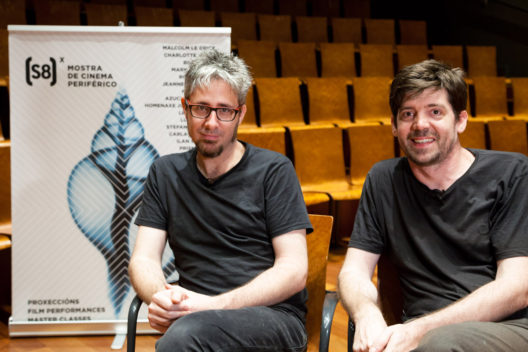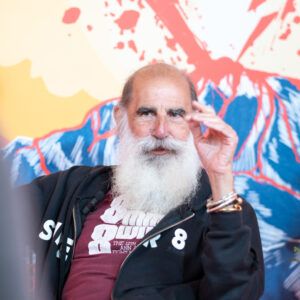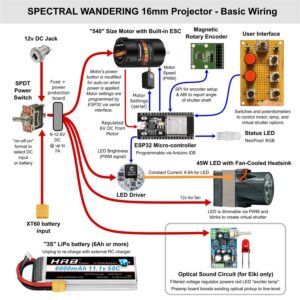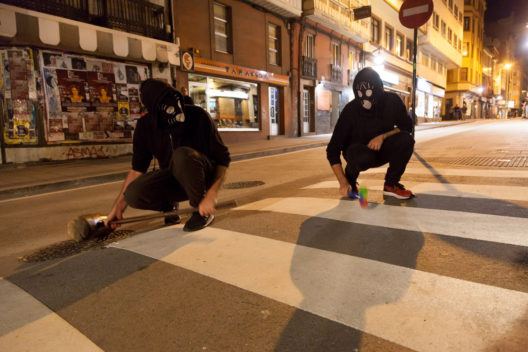
On May 31 the (S8) festival opened with the international premiere of 7 limbos, a film by Alexandre Cancelo and Berio Molina consisting in a series of audio performances (some of which overflew the boundaries of the screen to invade the streets of Coruña last Friday). This is what they told us about their project, which takes us on a trip through a ghostly, mesmerizing Europe.
I’ve learned that you come from different backgrounds, and I’m curious about the start of your collaboration, how it progressed, and what the filmmaking process was like, and what specific roles each one of you had in it.
Alexandre Cancelo: We already knew each other, we were friends. Plus, we used to be in similar social and working circles. I was part of Sinsal Audio, which is an association and a music festival. As for Berio, he was a member of Escoitar, another association whose work focuses on the limits in representing sound. So, there was this scene that you can see as a sort of cloud, and we met each other on that cloud. Some time later, that somehow led to starting this project. A project that I would say is the result of a dialogue among different fields and different people, and each one of us in our very own way contributed to create something that we never tried to limit, label, or classify in any way. We wanted to make a film, we wanted it to be cinema, but we were open to people labelling it as video art, or contemporary art, or whatever the film was to them. In that aspect the only barrier was the struggle of trying to express what we wanted to express.
How did your idea for this film change since it first came to your mind until the filmmaking process was complete?
Berio Molina: Well, it went through a number of phases. It’s something we actually started working on five years ago. It had a different name back then, and was a different project. We were interested in doing some sound actions in the street, with buildings… We wanted to get some sound out of them. That was the basic idea, and later we added more to it –the spectral, as we felt it had a lot to do with sound’s coming into existence, because sound is a presence you can’t see, and yet you know it’s there. It is also linked with the acousmatic. We realized that this connection between sound and sound actions was really close to the spectral. At some point, we got the idea of combining these two things, and, from there, we started knitting. The first step involved writing a script that we basically ended up ignoring, but it helped us create a number of situations and dialogues with other artists that were also working on sound and spectrality. We organised some encounters with them that mainly consisted in us going to their place and improvising, and then hoping that we could get something interesting out of that during the shooting. In the end, we had several parts that relied more on the script, and some other that were almost entirely improvised, and the film is a combination of them that we created during the editing process.
Now that you’ve mentioned spectrality, it seemed to me while watching the film that the locations had been chosen very carefully, as there is a general post-apocalyptic atmosphere to it. I mean, it’s been shot mainly among ruins of buildings, in empty places during the night, in the woods… It makes me feel like it’s the end of civilization. Was this intentional?
Alexandre Cancelo: Yes, that’s an idea that we definitely considered. It also has to do with the concept of limbo itself, and with the idea of ghosts and ghostly things. At some point we also created a general story, like a background story that somehow acted a thread for all the smaller stories that compose the film. And it’s an idea that’s also linked to that famous quote by Marx, “A spectre is haunting Europe”. In a way, we tried to put up a mise en scène of these words, imagining the possibility that a 200-year-old spectre could actually be haunting the streets of European cities nowadays. And thinking about memory as something that persists in space.
As for the structure of the film, I’m interested in your decision of dividing it into several chapters. It caught my attention that every chapter seems to be marked or represented with a drawing, some kind of symbol. What are they, exactly?
Berio Molina: The drawings are a selection of a series of illustrations by Hans Haeckel that were published under a Creative Commons licensed, and that we have always loved. They really act like fossils. I see them as a trace carved on the very skin of those spectres. As for the chapters, since the beginning we were drawn to this image –even though it’s not apparent in the film, but it’s true that it’s something that was always on our minds– of a gang, you know… Those films starred by gangsters wearing hoodies and baseball bats and whatnot… And we loved to think about them as gangsters, you know? Gangster ghosts wearing fossils as badges or symbols that represented them. And also the structure has to do with the actions we put in place, and it somehow is related with numbers. We thought that ten minutes, six, or seven… were an adequate duration for the actions, and that it would be good for the editing. Yeah, that was the main reason, it was about the numbers. Also, potential actions kept coming to mind, and suddenly we realized that we already had 7 of them, and… We felt it was a good idea, to break the symmetry. We had three plus three, plus one… The final chapter functions as a death, like the deaths that precede each of the previous chapters. We wanted to break the symmetry with a chapter that would act as an ending, and also… I don’t know, we just thought seven was a number that fitted the project.
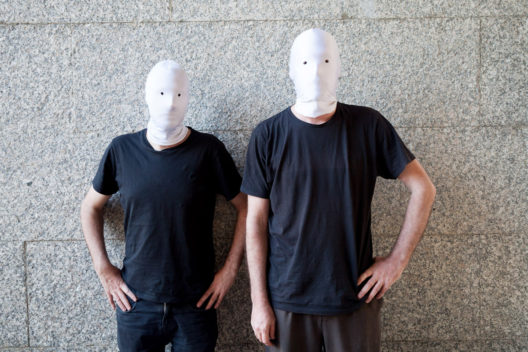
As for the final audio track of the film, is it the exact result of what happened during the shooting, I mean, the performance itself, or did you add some extras in the post-production phase?
Berio Molina: You mean the audio track that plays when the credits are shown?
Alexandre Cancelo: I think she means the final master. All the audio work –the editing, the design.
Berio Molina: I see. I understand you want to know whether it was mainly created in post-production or if we kept the raw sounds we recorded. Well, it actually depends on the chapter. For example, there is this chapter where they are hanging in the mines, in Casaio –we see the remains of the ruins, and they are hanging. Most of the audio track in that scene is made with recordings of the natural sounds that could be heard in that place. However, to build this idea that something was collapsing, we created a composition by putting together a number of sounds of falling objects. That was made in the post-production phase. However, the falling objects were recorded in that very place, and the sounds we hear are not alien to the ruins in any way.
Alexandre Cancelo: We put a lot of work in the sound production. There are a lot of layers to it, it certainly was a thorough effort.
Berio Molina: Yes, there are two moments where… The scenes of the whale and the mallet… There is a lot post-production work in there. In the mallet scene, many aspects of sound are considered: how it can manipulate reality, or the fact that it can be a potential acoustic weapon, as is the case with ship sirens, which call for the passengers when the ship is about leave; or with bells, which indicate us how manage our use of time… The character wielding the mallet alters the city, but he also alters the editing. He makes the sounds move from one shot to another. He hits the soundscape, and suddenly makes it move from the background to the foreground. This is a character that hits the editing so that sound travels among shots.
Alexandre Cancelo: Also, sound can have this ability to… reveal us, to reveal our manipulation of the film in some of its parts. It can reveal the people behind the camera, make them apparent… in the same way that it can reveal the people in front of the lens.
We are now at a festival where analogue cinema is given a major role. I’d like to know more about the role of analogue cinema in your film, as it appears to be very present in your prologue, in the ending, and also in your portraits of the artists.
Alexandre Cancelo: Yes, it was a way to materialize our wish to bring together different points of view, different ways of seeing. It was an idea that was of the original plan. It somehow made it to this point and eventually adopted this form. It was this idea that a ghost was watching us from outside, watching the creation of the film, like a ghost watching all the other ghosts. And it eventually took this shape. We didn’t want to be too literal, and this is not an aspect that we’ve especially wanted to highlight, but it’s true that we explicitly used the format with the aim to provide a contrast with the 4K format, so digital and highly defined. We thought of it as a way of identifying and showing the array of directions that the film can take.
